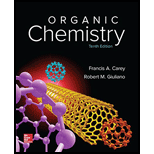
Organic Chemistry - Standalone book
10th Edition
ISBN: 9780073511214
Author: Francis A Carey Dr., Robert M. Giuliano
Publisher: McGraw-Hill Education
expand_more
expand_more
format_list_bulleted
Concept explainers
Textbook Question
Chapter 9.9, Problem 9P
Write a series of equations showing how you could prepare octane from acetylene and any necessary organic and inorganic reagents.
Expert Solution & Answer
Want to see the full answer?
Check out a sample textbook solution
Students have asked these similar questions
Write a series of equations showing how to prepare cis-5-decene from acetylene and 1–bromobutane as the source of all its carbons, using any necessary organic or inorganic reagents.
How to prepare ethane from ethyl iodide? Give the reaction.?
Starting with toluene (methylbenzene) and any other inorganic or organic reagents or catalysts, show a series of reactions (with reagents) for the synthesis of benzyl ethanoate (benzyl acetate).
Chapter 9 Solutions
Organic Chemistry - Standalone book
Ch. 9.1 - Prob. 1PCh. 9.2 - Prob. 2PCh. 9.4 - How do bond distances and bond strengths change...Ch. 9.5 - Complete each of the following equations to show...Ch. 9.6 - Prob. 5PCh. 9.6 - Which of the alkynes of molecular formula C5H8 can...Ch. 9.7 - Give the structures of three isomeric dibromides...Ch. 9.7 - Prob. 8PCh. 9.9 - Write a series of equations showing how you could...Ch. 9.9 - Write a series of equations showing how to prepare...
Ch. 9.10 - Prob. 11PCh. 9.11 - Give the structure of the enol formed by hydration...Ch. 9.11 - Prob. 13PCh. 9.13 - Prob. 14PCh. 9.14 - Prob. 15PCh. 9 - Provide the IUPAC name for each of the following...Ch. 9 - Prob. 17PCh. 9 - All compounds in Problem 9.17 are isomers except...Ch. 9 - Prob. 19PCh. 9 - Write structural formulas for all the alkynes of...Ch. 9 - Prob. 21PCh. 9 - Prob. 22PCh. 9 - The alkane formed by hydrogenation of...Ch. 9 - Write the structure of the major organic product...Ch. 9 - Write the structure of the major organic product...Ch. 9 - When 2-heptyne was treated with aqueous sulfuric...Ch. 9 - Prob. 27PCh. 9 - Prob. 28PCh. 9 - Prob. 29PCh. 9 - Show by writing appropriate chemical equations how...Ch. 9 - Show by writing appropriate chemical equations how...Ch. 9 - Diphenylacetylene can be synthesized by the double...Ch. 9 - (Z)-9-tricosene [ (Z)-CH3(CH2)7CH=CH(CH2)12CH3 ]...Ch. 9 - Prob. 34PCh. 9 - Prob. 35PCh. 9 - Prob. 36PCh. 9 - Alkynes undergo hydroboration to give...Ch. 9 - Prob. 38DSPCh. 9 - Prob. 39DSPCh. 9 - Prob. 40DSPCh. 9 - Prob. 41DSPCh. 9 - Thinking Mechanistically About Alkynes The...
Knowledge Booster
Learn more about
Need a deep-dive on the concept behind this application? Look no further. Learn more about this topic, chemistry and related others by exploring similar questions and additional content below.Similar questions
- Using the necessary inorganic reagents, propose the synthesis for 2,5-diphenylfuran from benzene and succinic acid.arrow_forwardWhat organic product would you obtain from reaction of 1-pentanol with CrO3, H2O, H2SO4?arrow_forwardDescribe a sequence of reactions by which 3-methyl-1-butyne can be straightforwardly prepared from acetylene.arrow_forward
- Using chemical equations, show how can you prepare: 3-pentene-1-ol using propyne and ethylene oxidearrow_forwardThe academic version of the process invention program (PIP) contains several examples, as follows: HDAl-hydrodealkylation of toluene to produce benzene CYHEXl-cyclohexane production by hydrogenation of benzene STYRl-styrene production from ethylbenzene XYLl-production of m-xylene from toluene ANHYDl-reaction of acetone and acetic acid to form acetic anhydride BUTALl-alkylation reaction of butene-1 and isobutane to produce iso-octane Select the “new plant design” mode and the “look at existing flow sheet” option, and follow the synthesis steps for one of these processes. ‘Obtain the current flow sheet as output at each level of the synthesis procedure. Also list the heuristics used at each step.arrow_forwardStarting with benzene, show the stepwise reactions necessary to form the highest yields for the following products. Include all reagents and reaction conditions.arrow_forward
- Show how to convert carboxylic acids to other functional groups, and devisemultistep syntheses using carboxylic acids as starting materials and intermediates.Explain how acid chlorides are used as activated derivatives of carboxylic acidsarrow_forwardIllustrate with equations the preparation of alkanes by Grignard synthesis.arrow_forwardSynthesize 2-Methyl-4-heptanone from 2-methyl-1-propanol and butanal using the organic or inorganic reagents that are neededarrow_forward
- What reactions and reagents can be used to make phenol from benzene if electrophilid aromatic substitution reactions are excluded?arrow_forwardThis triene reacts with excess maleic anhydride to produce a compound with molecular formula C14,H12,O6. Draw the structure of the product.arrow_forwardSuggest a chemical equation including reagent(s) and condition(s) for the following reaction. a) 3,4-dichloro-3-heptene from butyne.b) Hydration of propynearrow_forward
arrow_back_ios
SEE MORE QUESTIONS
arrow_forward_ios
Recommended textbooks for you
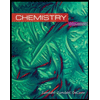 ChemistryChemistryISBN:9781305957404Author:Steven S. Zumdahl, Susan A. Zumdahl, Donald J. DeCostePublisher:Cengage Learning
ChemistryChemistryISBN:9781305957404Author:Steven S. Zumdahl, Susan A. Zumdahl, Donald J. DeCostePublisher:Cengage Learning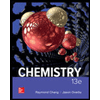 ChemistryChemistryISBN:9781259911156Author:Raymond Chang Dr., Jason Overby ProfessorPublisher:McGraw-Hill Education
ChemistryChemistryISBN:9781259911156Author:Raymond Chang Dr., Jason Overby ProfessorPublisher:McGraw-Hill Education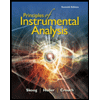 Principles of Instrumental AnalysisChemistryISBN:9781305577213Author:Douglas A. Skoog, F. James Holler, Stanley R. CrouchPublisher:Cengage Learning
Principles of Instrumental AnalysisChemistryISBN:9781305577213Author:Douglas A. Skoog, F. James Holler, Stanley R. CrouchPublisher:Cengage Learning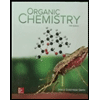 Organic ChemistryChemistryISBN:9780078021558Author:Janice Gorzynski Smith Dr.Publisher:McGraw-Hill Education
Organic ChemistryChemistryISBN:9780078021558Author:Janice Gorzynski Smith Dr.Publisher:McGraw-Hill Education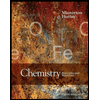 Chemistry: Principles and ReactionsChemistryISBN:9781305079373Author:William L. Masterton, Cecile N. HurleyPublisher:Cengage Learning
Chemistry: Principles and ReactionsChemistryISBN:9781305079373Author:William L. Masterton, Cecile N. HurleyPublisher:Cengage Learning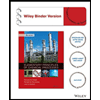 Elementary Principles of Chemical Processes, Bind...ChemistryISBN:9781118431221Author:Richard M. Felder, Ronald W. Rousseau, Lisa G. BullardPublisher:WILEY
Elementary Principles of Chemical Processes, Bind...ChemistryISBN:9781118431221Author:Richard M. Felder, Ronald W. Rousseau, Lisa G. BullardPublisher:WILEY

Chemistry
Chemistry
ISBN:9781305957404
Author:Steven S. Zumdahl, Susan A. Zumdahl, Donald J. DeCoste
Publisher:Cengage Learning

Chemistry
Chemistry
ISBN:9781259911156
Author:Raymond Chang Dr., Jason Overby Professor
Publisher:McGraw-Hill Education

Principles of Instrumental Analysis
Chemistry
ISBN:9781305577213
Author:Douglas A. Skoog, F. James Holler, Stanley R. Crouch
Publisher:Cengage Learning

Organic Chemistry
Chemistry
ISBN:9780078021558
Author:Janice Gorzynski Smith Dr.
Publisher:McGraw-Hill Education

Chemistry: Principles and Reactions
Chemistry
ISBN:9781305079373
Author:William L. Masterton, Cecile N. Hurley
Publisher:Cengage Learning

Elementary Principles of Chemical Processes, Bind...
Chemistry
ISBN:9781118431221
Author:Richard M. Felder, Ronald W. Rousseau, Lisa G. Bullard
Publisher:WILEY
Alcohols, Ethers, and Epoxides: Crash Course Organic Chemistry #24; Author: Crash Course;https://www.youtube.com/watch?v=j04zMFwDeDU;License: Standard YouTube License, CC-BY